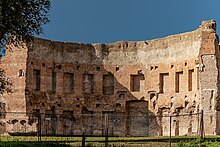
Bathing played a major part in ancient Roman culture and society. It was one of the most common daily activities and was practised across a wide variety of social classes.[1][2] Though many contemporary cultures see bathing as a very private activity conducted in the home, bathing in Rome was a communal activity. While the extremely wealthy could afford bathing facilities in their homes, private baths were very uncommon, and most people bathed in the communal baths (thermae).[1] In some ways, these resembled modern-day destination spas as there were facilities for a variety of activities from exercising to sunbathing to swimming and massage.[1]
Such was the importance of baths to Romans that a catalogue of buildings in Rome from 354 AD documented 952 baths of varying sizes in the city.[3] Public baths became common throughout the empire as a symbol of "Romanitas" or a way to define themselves as Roman.[4] They were some of the most common and most important public buildings in the empire as some of the first buildings built after the empire would conquer a new area.[4]
Although the wealthiest Romans might set up a bath in their townhouses or their country villas, heating a series of rooms or even a separate building especially for this purpose, and soldiers might have a bathhouse provided at their fort (as at Cilurnum on Hadrian's Wall, or at Bearsden fort), they still often frequented the numerous public bathhouses in the cities and towns throughout the empire.
Small bathhouses, called balneum (plural balnea), might be privately owned, while they were public in the sense that they were open to the populace for a fee. Larger baths called thermae were owned by the state and often covered several city blocks. The largest of these, the Baths of Diocletian, could hold up to 3,000 bathers. Fees for both types of baths were quite reasonable, within the budget of most free Roman males.
- ^ a b c Beard, Mary (2008). The fires of Vesuvius : Pompeii lost and found. Cambridge, Mass.: Belknap Press of Harvard University Press. ISBN 978-0-674-02976-7. OCLC 225874239.
- ^ Laurence, Ray (2009). Roman Passions : a History of Pleasure in Imperial Rome. London: Bloomsbury Publishing PLC. ISBN 978-1-4411-0339-0. OCLC 1027148260.
- ^ Boëthius, Axel; Ward-Perkins, J. B. (1970). Etruscan and Roman architecture. Harmondsworth: Penguin. ISBN 0-14-056032-7.
- ^ a b "Ancient Mediterranean Baths and Bathing". obo. Retrieved 2022-04-28.
